The Impact of Socio-Economic Factors on Health in the UK
VerifiedAdded on 2023/01/06
|37
|14340
|82
Report
AI Summary
This report, focusing on socio-economic factors and their effects on health in the UK, examines the interplay between income, education, and health outcomes. It explores the concept of social determinants, identifying health challenges associated with socio-economic disparities, such as unequal access to healthcare and the impact on chronic disease prevalence. The research methodology employs a qualitative approach, utilizing secondary data from government reports, academic journals, and other reliable sources. The report highlights the significant impact of socio-economic factors on health, including the role of employment, income, and education in shaping health-related choices and outcomes. It investigates the health challenges faced by low socioeconomic populations and explores initiatives undertaken by the NHS to address these inequalities, offering recommendations for future interventions. The report concludes with a discussion of potential alternative methods for addressing socio-economic health disparities, emphasizing the importance of targeted interventions and policy changes to improve health equity.
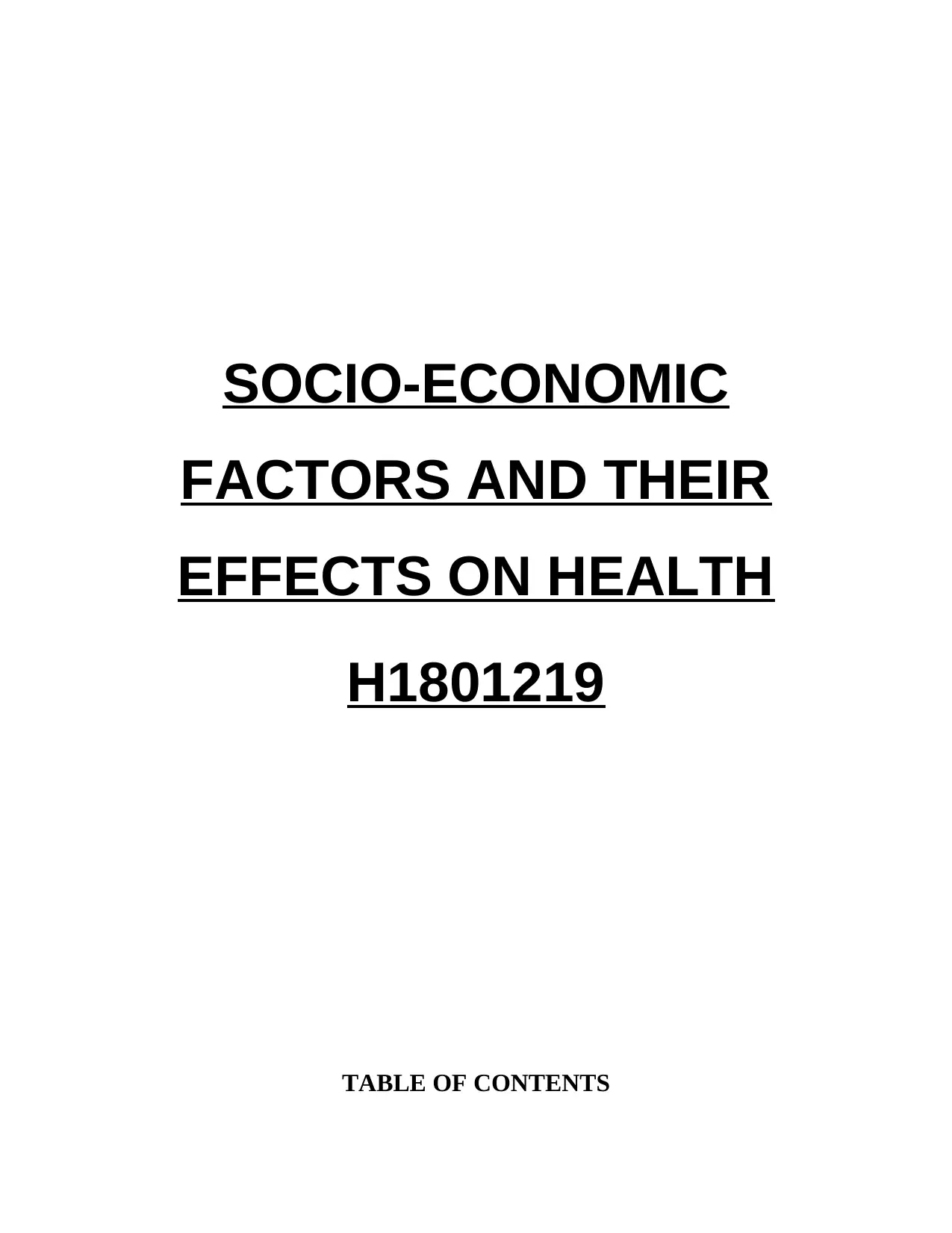
SOCIO-ECONOMIC
FACTORS AND THEIR
EFFECTS ON HEALTH
H1801219
TABLE OF CONTENTS
FACTORS AND THEIR
EFFECTS ON HEALTH
H1801219
TABLE OF CONTENTS
Paraphrase This Document
Need a fresh take? Get an instant paraphrase of this document with our AI Paraphraser
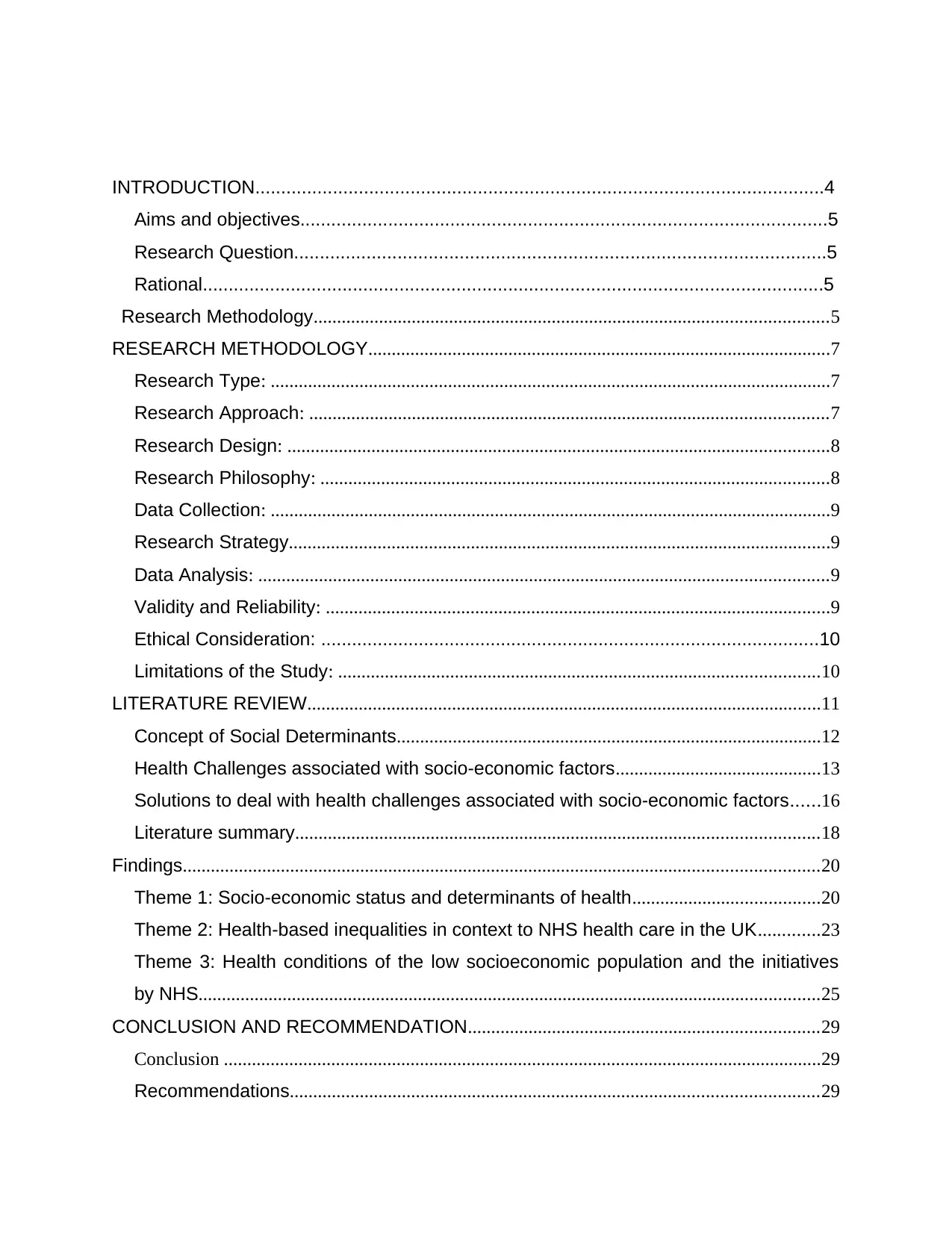
INTRODUCTION..............................................................................................................4
Aims and objectives......................................................................................................5
Research Question.......................................................................................................5
Rational........................................................................................................................5
Research Methodology..............................................................................................................5
RESEARCH METHODOLOGY...................................................................................................7
Research Type: ........................................................................................................................7
Research Approach: ...............................................................................................................7
Research Design: ....................................................................................................................8
Research Philosophy: .............................................................................................................8
Data Collection: ........................................................................................................................9
Research Strategy....................................................................................................................9
Data Analysis: ..........................................................................................................................9
Validity and Reliability: ............................................................................................................9
Ethical Consideration: .................................................................................................10
Limitations of the Study: .......................................................................................................10
LITERATURE REVIEW..............................................................................................................11
Concept of Social Determinants...........................................................................................12
Health Challenges associated with socio-economic factors............................................13
Solutions to deal with health challenges associated with socio-economic factors......16
Literature summary................................................................................................................18
Findings........................................................................................................................................20
Theme 1: Socio-economic status and determinants of health........................................20
Theme 2: Health-based inequalities in context to NHS health care in the UK.............23
Theme 3: Health conditions of the low socioeconomic population and the initiatives
by NHS.....................................................................................................................................25
CONCLUSION AND RECOMMENDATION...........................................................................29
Conclusion ................................................................................................................................29
Recommendations.................................................................................................................29
Aims and objectives......................................................................................................5
Research Question.......................................................................................................5
Rational........................................................................................................................5
Research Methodology..............................................................................................................5
RESEARCH METHODOLOGY...................................................................................................7
Research Type: ........................................................................................................................7
Research Approach: ...............................................................................................................7
Research Design: ....................................................................................................................8
Research Philosophy: .............................................................................................................8
Data Collection: ........................................................................................................................9
Research Strategy....................................................................................................................9
Data Analysis: ..........................................................................................................................9
Validity and Reliability: ............................................................................................................9
Ethical Consideration: .................................................................................................10
Limitations of the Study: .......................................................................................................10
LITERATURE REVIEW..............................................................................................................11
Concept of Social Determinants...........................................................................................12
Health Challenges associated with socio-economic factors............................................13
Solutions to deal with health challenges associated with socio-economic factors......16
Literature summary................................................................................................................18
Findings........................................................................................................................................20
Theme 1: Socio-economic status and determinants of health........................................20
Theme 2: Health-based inequalities in context to NHS health care in the UK.............23
Theme 3: Health conditions of the low socioeconomic population and the initiatives
by NHS.....................................................................................................................................25
CONCLUSION AND RECOMMENDATION...........................................................................29
Conclusion ................................................................................................................................29
Recommendations.................................................................................................................29

Alternative Method: .............................................................................................................31
REFERENCES..............................................................................................................................34
REFERENCES..............................................................................................................................34
⊘ This is a preview!⊘
Do you want full access?
Subscribe today to unlock all pages.

Trusted by 1+ million students worldwide
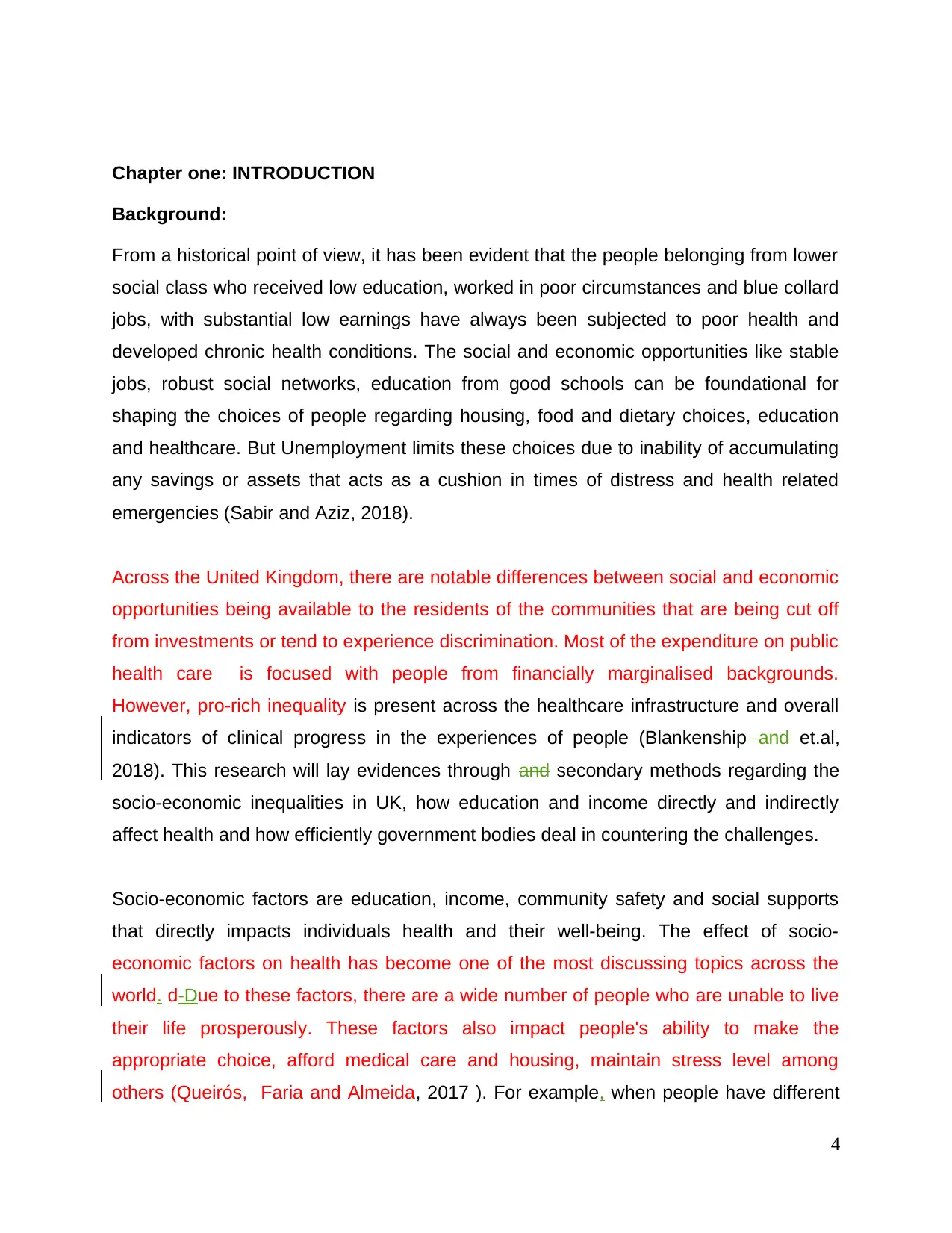
Chapter one: INTRODUCTION
Background:
From a historical point of view, it has been evident that the people belonging from lower
social class who received low education, worked in poor circumstances and blue collard
jobs, with substantial low earnings have always been subjected to poor health and
developed chronic health conditions. The social and economic opportunities like stable
jobs, robust social networks, education from good schools can be foundational for
shaping the choices of people regarding housing, food and dietary choices, education
and healthcare. But Unemployment limits these choices due to inability of accumulating
any savings or assets that acts as a cushion in times of distress and health related
emergencies (Sabir and Aziz, 2018).
Across the United Kingdom, there are notable differences between social and economic
opportunities being available to the residents of the communities that are being cut off
from investments or tend to experience discrimination. Most of the expenditure on public
health care is focused with people from financially marginalised backgrounds.
However, pro-rich inequality is present across the healthcare infrastructure and overall
indicators of clinical progress in the experiences of people (Blankenship and et.al,
2018). This research will lay evidences through and secondary methods regarding the
socio-economic inequalities in UK, how education and income directly and indirectly
affect health and how efficiently government bodies deal in countering the challenges.
Socio-economic factors are education, income, community safety and social supports
that directly impacts individuals health and their well-being. The effect of socio-
economic factors on health has become one of the most discussing topics across the
world. d-Due to these factors, there are a wide number of people who are unable to live
their life prosperously. These factors also impact people's ability to make the
appropriate choice, afford medical care and housing, maintain stress level among
others (Queirós, Faria and Almeida, 2017 ). For example, when people have different
4
Background:
From a historical point of view, it has been evident that the people belonging from lower
social class who received low education, worked in poor circumstances and blue collard
jobs, with substantial low earnings have always been subjected to poor health and
developed chronic health conditions. The social and economic opportunities like stable
jobs, robust social networks, education from good schools can be foundational for
shaping the choices of people regarding housing, food and dietary choices, education
and healthcare. But Unemployment limits these choices due to inability of accumulating
any savings or assets that acts as a cushion in times of distress and health related
emergencies (Sabir and Aziz, 2018).
Across the United Kingdom, there are notable differences between social and economic
opportunities being available to the residents of the communities that are being cut off
from investments or tend to experience discrimination. Most of the expenditure on public
health care is focused with people from financially marginalised backgrounds.
However, pro-rich inequality is present across the healthcare infrastructure and overall
indicators of clinical progress in the experiences of people (Blankenship and et.al,
2018). This research will lay evidences through and secondary methods regarding the
socio-economic inequalities in UK, how education and income directly and indirectly
affect health and how efficiently government bodies deal in countering the challenges.
Socio-economic factors are education, income, community safety and social supports
that directly impacts individuals health and their well-being. The effect of socio-
economic factors on health has become one of the most discussing topics across the
world. d-Due to these factors, there are a wide number of people who are unable to live
their life prosperously. These factors also impact people's ability to make the
appropriate choice, afford medical care and housing, maintain stress level among
others (Queirós, Faria and Almeida, 2017 ). For example, when people have different
4
Paraphrase This Document
Need a fresh take? Get an instant paraphrase of this document with our AI Paraphraser
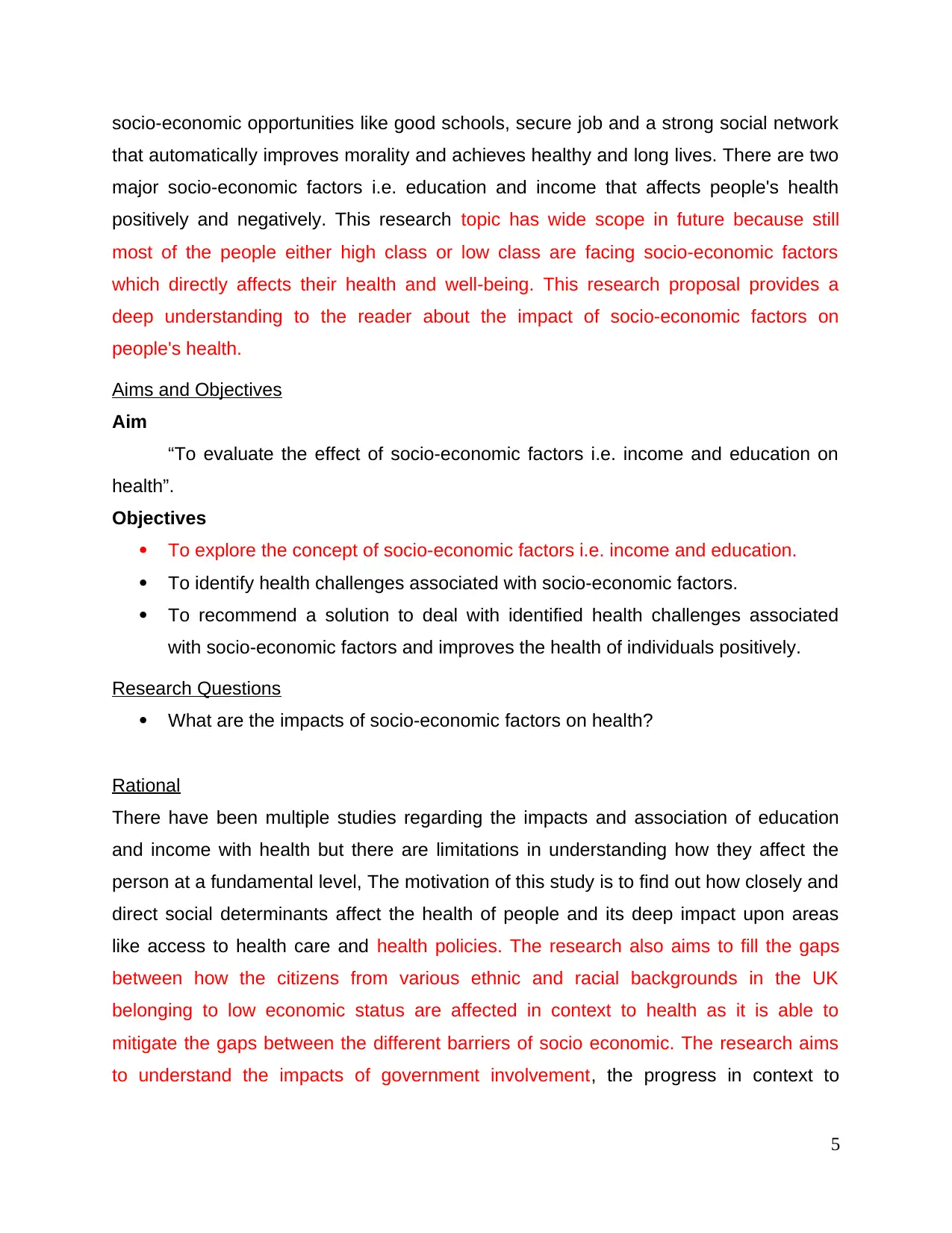
socio-economic opportunities like good schools, secure job and a strong social network
that automatically improves morality and achieves healthy and long lives. There are two
major socio-economic factors i.e. education and income that affects people's health
positively and negatively. This research topic has wide scope in future because still
most of the people either high class or low class are facing socio-economic factors
which directly affects their health and well-being. This research proposal provides a
deep understanding to the reader about the impact of socio-economic factors on
people's health.
Aims and Objectives
Aim
“To evaluate the effect of socio-economic factors i.e. income and education on
health”.
Objectives
To explore the concept of socio-economic factors i.e. income and education.
To identify health challenges associated with socio-economic factors.
To recommend a solution to deal with identified health challenges associated
with socio-economic factors and improves the health of individuals positively.
Research Questions
What are the impacts of socio-economic factors on health?
Rational
There have been multiple studies regarding the impacts and association of education
and income with health but there are limitations in understanding how they affect the
person at a fundamental level, The motivation of this study is to find out how closely and
direct social determinants affect the health of people and its deep impact upon areas
like access to health care and health policies. The research also aims to fill the gaps
between how the citizens from various ethnic and racial backgrounds in the UK
belonging to low economic status are affected in context to health as it is able to
mitigate the gaps between the different barriers of socio economic. The research aims
to understand the impacts of government involvement, the progress in context to
5
that automatically improves morality and achieves healthy and long lives. There are two
major socio-economic factors i.e. education and income that affects people's health
positively and negatively. This research topic has wide scope in future because still
most of the people either high class or low class are facing socio-economic factors
which directly affects their health and well-being. This research proposal provides a
deep understanding to the reader about the impact of socio-economic factors on
people's health.
Aims and Objectives
Aim
“To evaluate the effect of socio-economic factors i.e. income and education on
health”.
Objectives
To explore the concept of socio-economic factors i.e. income and education.
To identify health challenges associated with socio-economic factors.
To recommend a solution to deal with identified health challenges associated
with socio-economic factors and improves the health of individuals positively.
Research Questions
What are the impacts of socio-economic factors on health?
Rational
There have been multiple studies regarding the impacts and association of education
and income with health but there are limitations in understanding how they affect the
person at a fundamental level, The motivation of this study is to find out how closely and
direct social determinants affect the health of people and its deep impact upon areas
like access to health care and health policies. The research also aims to fill the gaps
between how the citizens from various ethnic and racial backgrounds in the UK
belonging to low economic status are affected in context to health as it is able to
mitigate the gaps between the different barriers of socio economic. The research aims
to understand the impacts of government involvement, the progress in context to
5
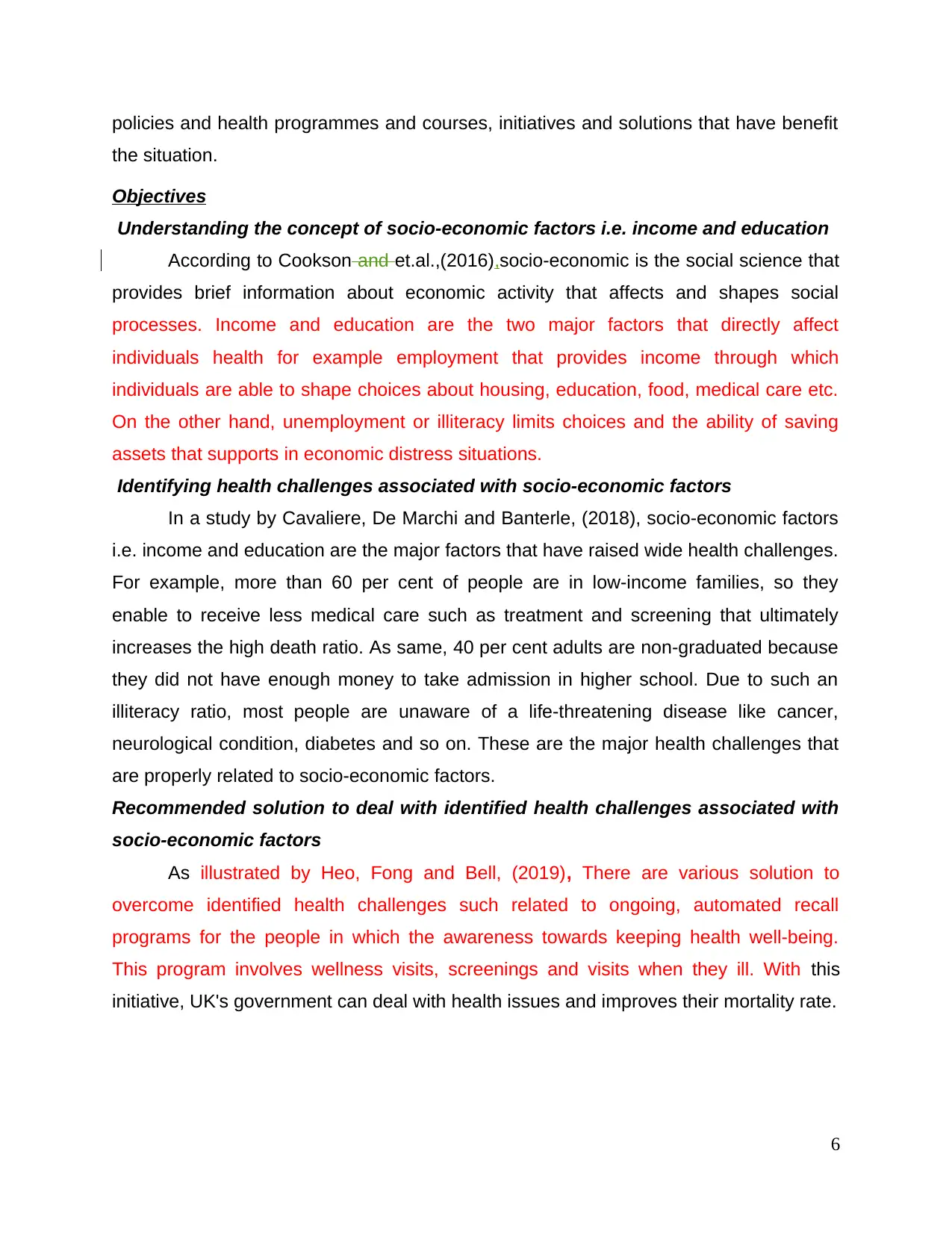
policies and health programmes and courses, initiatives and solutions that have benefit
the situation.
Objectives
Understanding the concept of socio-economic factors i.e. income and education
According to Cookson and et.al.,(2016),socio-economic is the social science that
provides brief information about economic activity that affects and shapes social
processes. Income and education are the two major factors that directly affect
individuals health for example employment that provides income through which
individuals are able to shape choices about housing, education, food, medical care etc.
On the other hand, unemployment or illiteracy limits choices and the ability of saving
assets that supports in economic distress situations.
Identifying health challenges associated with socio-economic factors
In a study by Cavaliere, De Marchi and Banterle, (2018), socio-economic factors
i.e. income and education are the major factors that have raised wide health challenges.
For example, more than 60 per cent of people are in low-income families, so they
enable to receive less medical care such as treatment and screening that ultimately
increases the high death ratio. As same, 40 per cent adults are non-graduated because
they did not have enough money to take admission in higher school. Due to such an
illiteracy ratio, most people are unaware of a life-threatening disease like cancer,
neurological condition, diabetes and so on. These are the major health challenges that
are properly related to socio-economic factors.
Recommended solution to deal with identified health challenges associated with
socio-economic factors
As illustrated by Heo, Fong and Bell, (2019), There are various solution to
overcome identified health challenges such related to ongoing, automated recall
programs for the people in which the awareness towards keeping health well-being.
This program involves wellness visits, screenings and visits when they ill. With this
initiative, UK's government can deal with health issues and improves their mortality rate.
6
the situation.
Objectives
Understanding the concept of socio-economic factors i.e. income and education
According to Cookson and et.al.,(2016),socio-economic is the social science that
provides brief information about economic activity that affects and shapes social
processes. Income and education are the two major factors that directly affect
individuals health for example employment that provides income through which
individuals are able to shape choices about housing, education, food, medical care etc.
On the other hand, unemployment or illiteracy limits choices and the ability of saving
assets that supports in economic distress situations.
Identifying health challenges associated with socio-economic factors
In a study by Cavaliere, De Marchi and Banterle, (2018), socio-economic factors
i.e. income and education are the major factors that have raised wide health challenges.
For example, more than 60 per cent of people are in low-income families, so they
enable to receive less medical care such as treatment and screening that ultimately
increases the high death ratio. As same, 40 per cent adults are non-graduated because
they did not have enough money to take admission in higher school. Due to such an
illiteracy ratio, most people are unaware of a life-threatening disease like cancer,
neurological condition, diabetes and so on. These are the major health challenges that
are properly related to socio-economic factors.
Recommended solution to deal with identified health challenges associated with
socio-economic factors
As illustrated by Heo, Fong and Bell, (2019), There are various solution to
overcome identified health challenges such related to ongoing, automated recall
programs for the people in which the awareness towards keeping health well-being.
This program involves wellness visits, screenings and visits when they ill. With this
initiative, UK's government can deal with health issues and improves their mortality rate.
6
⊘ This is a preview!⊘
Do you want full access?
Subscribe today to unlock all pages.

Trusted by 1+ million students worldwide
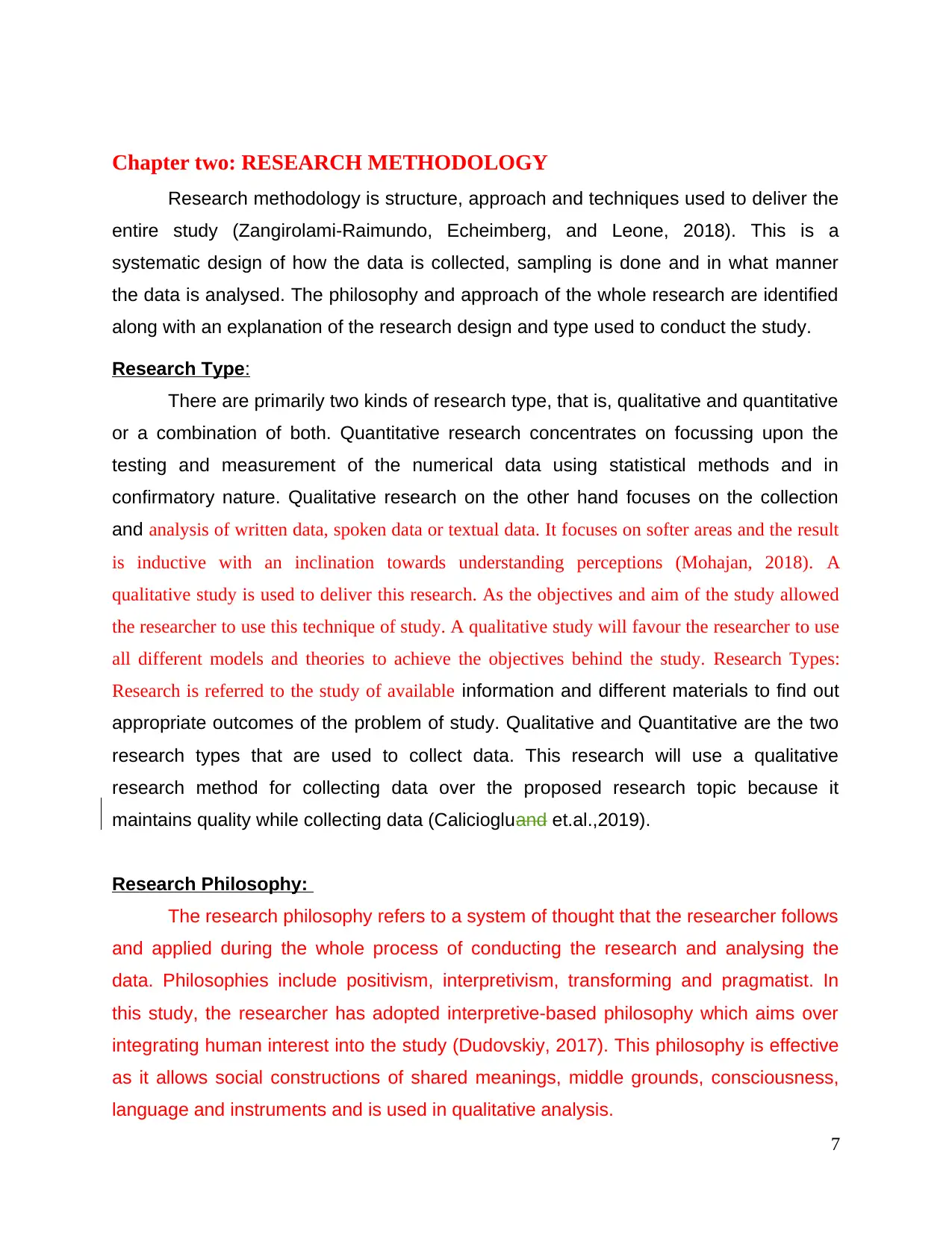
Chapter two: RESEARCH METHODOLOGY
Research methodology is structure, approach and techniques used to deliver the
entire study (Zangirolami-Raimundo, Echeimberg, and Leone, 2018). This is a
systematic design of how the data is collected, sampling is done and in what manner
the data is analysed. The philosophy and approach of the whole research are identified
along with an explanation of the research design and type used to conduct the study.
Research Type:
There are primarily two kinds of research type, that is, qualitative and quantitative
or a combination of both. Quantitative research concentrates on focussing upon the
testing and measurement of the numerical data using statistical methods and in
confirmatory nature. Qualitative research on the other hand focuses on the collection
and analysis of written data, spoken data or textual data. It focuses on softer areas and the result
is inductive with an inclination towards understanding perceptions (Mohajan, 2018). A
qualitative study is used to deliver this research. As the objectives and aim of the study allowed
the researcher to use this technique of study. A qualitative study will favour the researcher to use
all different models and theories to achieve the objectives behind the study. Research Types:
Research is referred to the study of available information and different materials to find out
appropriate outcomes of the problem of study. Qualitative and Quantitative are the two
research types that are used to collect data. This research will use a qualitative
research method for collecting data over the proposed research topic because it
maintains quality while collecting data (Caliciogluand et.al.,2019).
Research Philosophy:
The research philosophy refers to a system of thought that the researcher follows
and applied during the whole process of conducting the research and analysing the
data. Philosophies include positivism, interpretivism, transforming and pragmatist. In
this study, the researcher has adopted interpretive-based philosophy which aims over
integrating human interest into the study (Dudovskiy, 2017). This philosophy is effective
as it allows social constructions of shared meanings, middle grounds, consciousness,
language and instruments and is used in qualitative analysis.
7
Research methodology is structure, approach and techniques used to deliver the
entire study (Zangirolami-Raimundo, Echeimberg, and Leone, 2018). This is a
systematic design of how the data is collected, sampling is done and in what manner
the data is analysed. The philosophy and approach of the whole research are identified
along with an explanation of the research design and type used to conduct the study.
Research Type:
There are primarily two kinds of research type, that is, qualitative and quantitative
or a combination of both. Quantitative research concentrates on focussing upon the
testing and measurement of the numerical data using statistical methods and in
confirmatory nature. Qualitative research on the other hand focuses on the collection
and analysis of written data, spoken data or textual data. It focuses on softer areas and the result
is inductive with an inclination towards understanding perceptions (Mohajan, 2018). A
qualitative study is used to deliver this research. As the objectives and aim of the study allowed
the researcher to use this technique of study. A qualitative study will favour the researcher to use
all different models and theories to achieve the objectives behind the study. Research Types:
Research is referred to the study of available information and different materials to find out
appropriate outcomes of the problem of study. Qualitative and Quantitative are the two
research types that are used to collect data. This research will use a qualitative
research method for collecting data over the proposed research topic because it
maintains quality while collecting data (Caliciogluand et.al.,2019).
Research Philosophy:
The research philosophy refers to a system of thought that the researcher follows
and applied during the whole process of conducting the research and analysing the
data. Philosophies include positivism, interpretivism, transforming and pragmatist. In
this study, the researcher has adopted interpretive-based philosophy which aims over
integrating human interest into the study (Dudovskiy, 2017). This philosophy is effective
as it allows social constructions of shared meanings, middle grounds, consciousness,
language and instruments and is used in qualitative analysis.
7
Paraphrase This Document
Need a fresh take? Get an instant paraphrase of this document with our AI Paraphraser
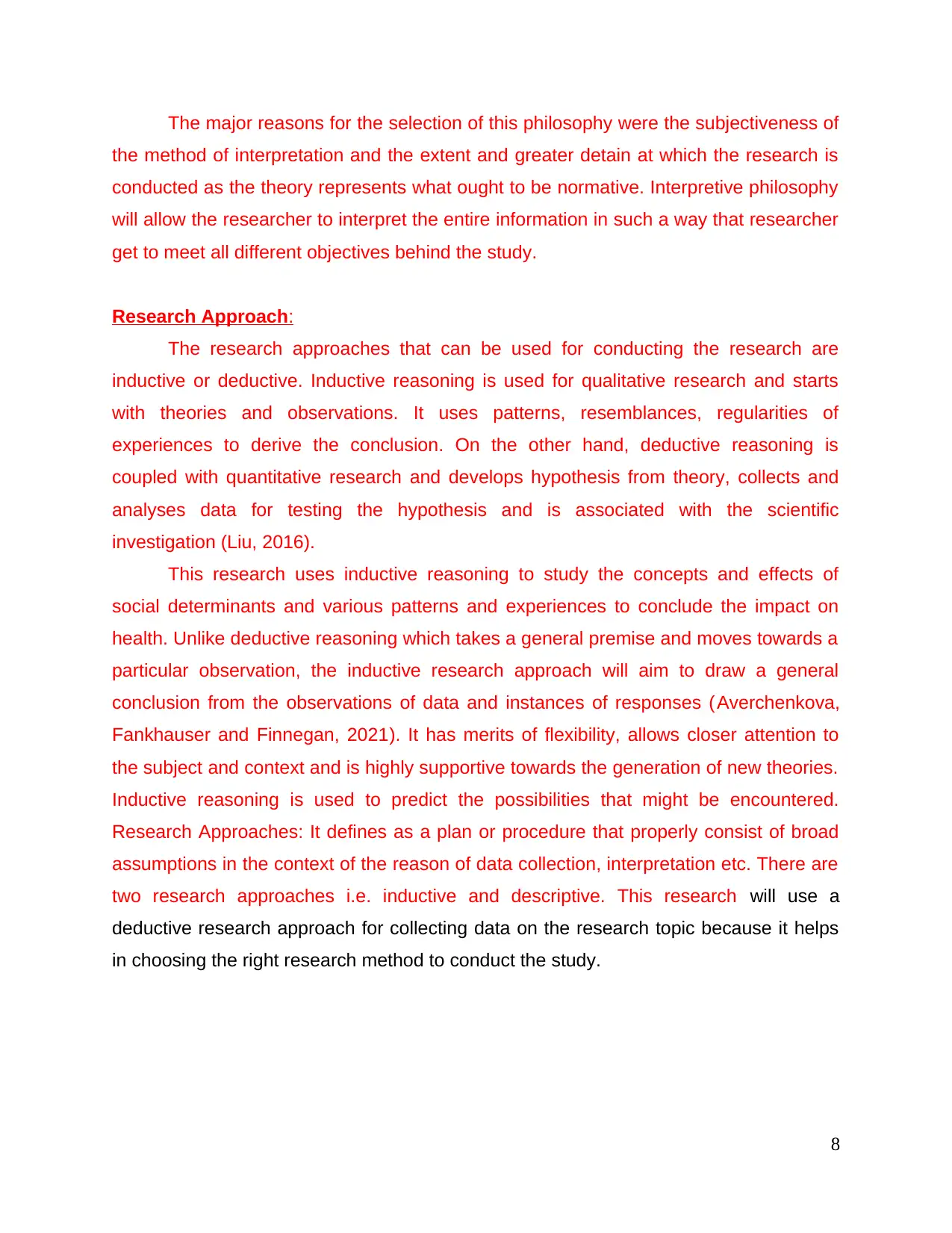
The major reasons for the selection of this philosophy were the subjectiveness of
the method of interpretation and the extent and greater detain at which the research is
conducted as the theory represents what ought to be normative. Interpretive philosophy
will allow the researcher to interpret the entire information in such a way that researcher
get to meet all different objectives behind the study.
Research Approach:
The research approaches that can be used for conducting the research are
inductive or deductive. Inductive reasoning is used for qualitative research and starts
with theories and observations. It uses patterns, resemblances, regularities of
experiences to derive the conclusion. On the other hand, deductive reasoning is
coupled with quantitative research and develops hypothesis from theory, collects and
analyses data for testing the hypothesis and is associated with the scientific
investigation (Liu, 2016).
This research uses inductive reasoning to study the concepts and effects of
social determinants and various patterns and experiences to conclude the impact on
health. Unlike deductive reasoning which takes a general premise and moves towards a
particular observation, the inductive research approach will aim to draw a general
conclusion from the observations of data and instances of responses (Averchenkova,
Fankhauser and Finnegan, 2021). It has merits of flexibility, allows closer attention to
the subject and context and is highly supportive towards the generation of new theories.
Inductive reasoning is used to predict the possibilities that might be encountered.
Research Approaches: It defines as a plan or procedure that properly consist of broad
assumptions in the context of the reason of data collection, interpretation etc. There are
two research approaches i.e. inductive and descriptive. This research will use a
deductive research approach for collecting data on the research topic because it helps
in choosing the right research method to conduct the study.
8
the method of interpretation and the extent and greater detain at which the research is
conducted as the theory represents what ought to be normative. Interpretive philosophy
will allow the researcher to interpret the entire information in such a way that researcher
get to meet all different objectives behind the study.
Research Approach:
The research approaches that can be used for conducting the research are
inductive or deductive. Inductive reasoning is used for qualitative research and starts
with theories and observations. It uses patterns, resemblances, regularities of
experiences to derive the conclusion. On the other hand, deductive reasoning is
coupled with quantitative research and develops hypothesis from theory, collects and
analyses data for testing the hypothesis and is associated with the scientific
investigation (Liu, 2016).
This research uses inductive reasoning to study the concepts and effects of
social determinants and various patterns and experiences to conclude the impact on
health. Unlike deductive reasoning which takes a general premise and moves towards a
particular observation, the inductive research approach will aim to draw a general
conclusion from the observations of data and instances of responses (Averchenkova,
Fankhauser and Finnegan, 2021). It has merits of flexibility, allows closer attention to
the subject and context and is highly supportive towards the generation of new theories.
Inductive reasoning is used to predict the possibilities that might be encountered.
Research Approaches: It defines as a plan or procedure that properly consist of broad
assumptions in the context of the reason of data collection, interpretation etc. There are
two research approaches i.e. inductive and descriptive. This research will use a
deductive research approach for collecting data on the research topic because it helps
in choosing the right research method to conduct the study.
8
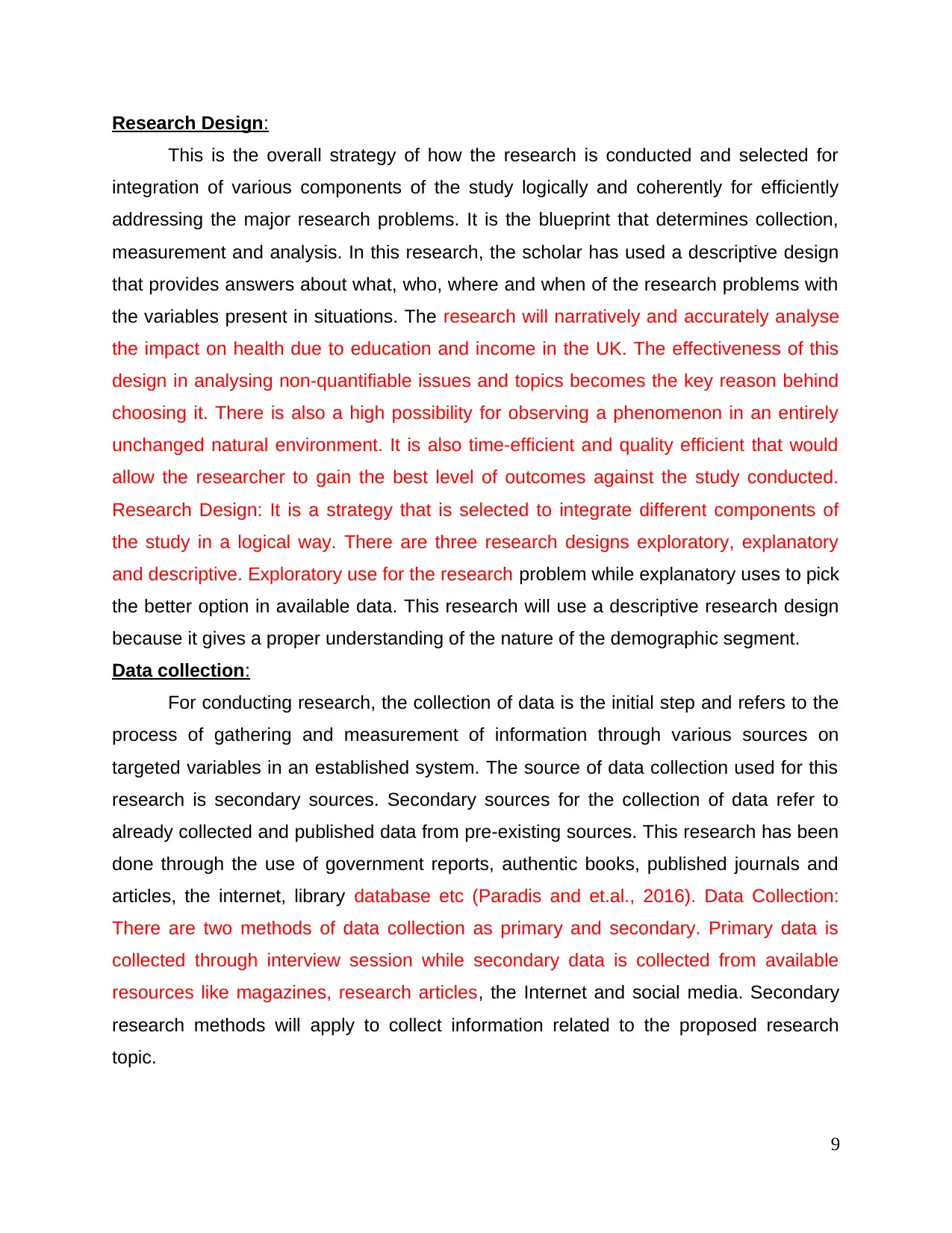
Research Design:
This is the overall strategy of how the research is conducted and selected for
integration of various components of the study logically and coherently for efficiently
addressing the major research problems. It is the blueprint that determines collection,
measurement and analysis. In this research, the scholar has used a descriptive design
that provides answers about what, who, where and when of the research problems with
the variables present in situations. The research will narratively and accurately analyse
the impact on health due to education and income in the UK. The effectiveness of this
design in analysing non-quantifiable issues and topics becomes the key reason behind
choosing it. There is also a high possibility for observing a phenomenon in an entirely
unchanged natural environment. It is also time-efficient and quality efficient that would
allow the researcher to gain the best level of outcomes against the study conducted.
Research Design: It is a strategy that is selected to integrate different components of
the study in a logical way. There are three research designs exploratory, explanatory
and descriptive. Exploratory use for the research problem while explanatory uses to pick
the better option in available data. This research will use a descriptive research design
because it gives a proper understanding of the nature of the demographic segment.
Data collection:
For conducting research, the collection of data is the initial step and refers to the
process of gathering and measurement of information through various sources on
targeted variables in an established system. The source of data collection used for this
research is secondary sources. Secondary sources for the collection of data refer to
already collected and published data from pre-existing sources. This research has been
done through the use of government reports, authentic books, published journals and
articles, the internet, library database etc (Paradis and et.al., 2016). Data Collection:
There are two methods of data collection as primary and secondary. Primary data is
collected through interview session while secondary data is collected from available
resources like magazines, research articles, the Internet and social media. Secondary
research methods will apply to collect information related to the proposed research
topic.
9
This is the overall strategy of how the research is conducted and selected for
integration of various components of the study logically and coherently for efficiently
addressing the major research problems. It is the blueprint that determines collection,
measurement and analysis. In this research, the scholar has used a descriptive design
that provides answers about what, who, where and when of the research problems with
the variables present in situations. The research will narratively and accurately analyse
the impact on health due to education and income in the UK. The effectiveness of this
design in analysing non-quantifiable issues and topics becomes the key reason behind
choosing it. There is also a high possibility for observing a phenomenon in an entirely
unchanged natural environment. It is also time-efficient and quality efficient that would
allow the researcher to gain the best level of outcomes against the study conducted.
Research Design: It is a strategy that is selected to integrate different components of
the study in a logical way. There are three research designs exploratory, explanatory
and descriptive. Exploratory use for the research problem while explanatory uses to pick
the better option in available data. This research will use a descriptive research design
because it gives a proper understanding of the nature of the demographic segment.
Data collection:
For conducting research, the collection of data is the initial step and refers to the
process of gathering and measurement of information through various sources on
targeted variables in an established system. The source of data collection used for this
research is secondary sources. Secondary sources for the collection of data refer to
already collected and published data from pre-existing sources. This research has been
done through the use of government reports, authentic books, published journals and
articles, the internet, library database etc (Paradis and et.al., 2016). Data Collection:
There are two methods of data collection as primary and secondary. Primary data is
collected through interview session while secondary data is collected from available
resources like magazines, research articles, the Internet and social media. Secondary
research methods will apply to collect information related to the proposed research
topic.
9
⊘ This is a preview!⊘
Do you want full access?
Subscribe today to unlock all pages.

Trusted by 1+ million students worldwide
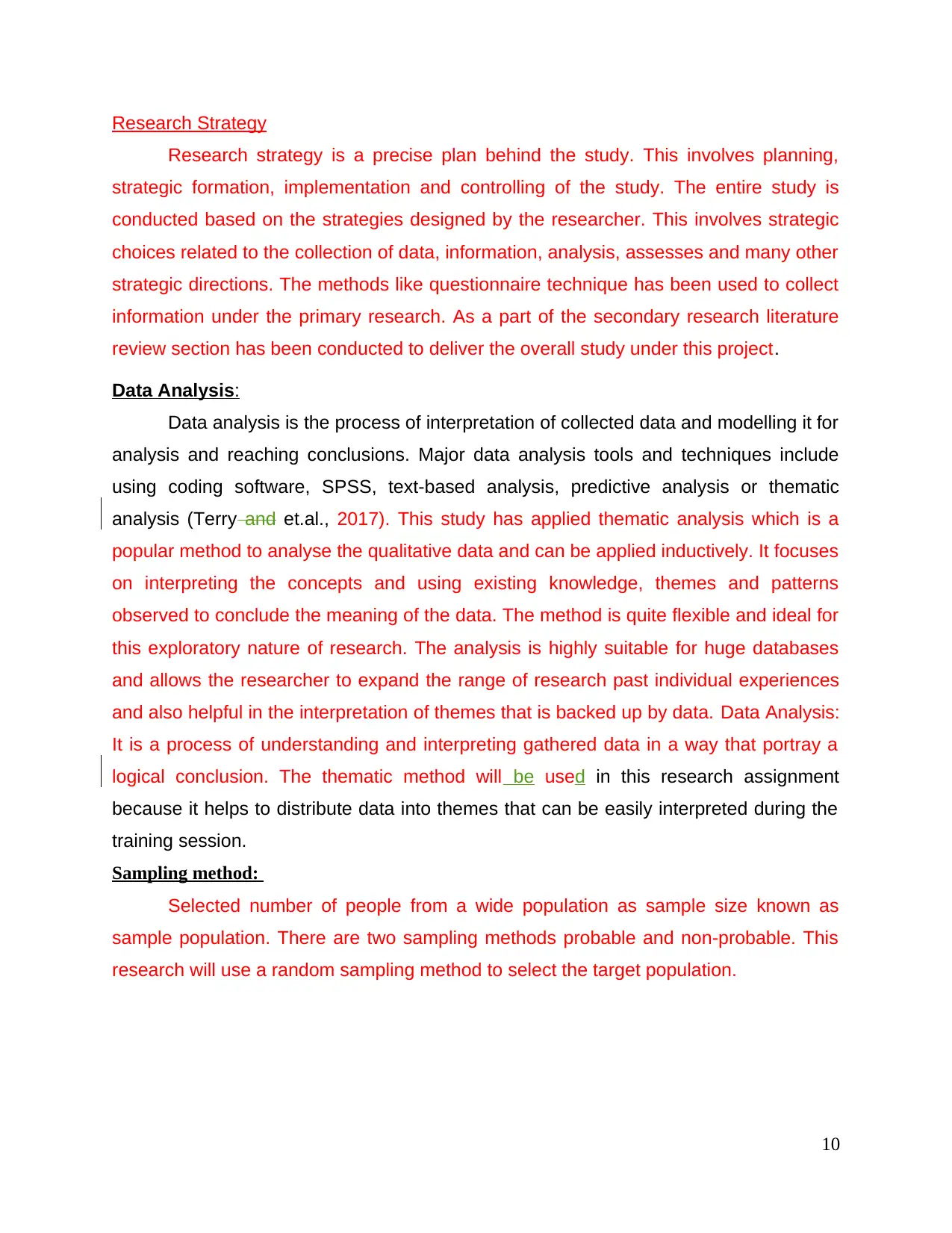
Research Strategy
Research strategy is a precise plan behind the study. This involves planning,
strategic formation, implementation and controlling of the study. The entire study is
conducted based on the strategies designed by the researcher. This involves strategic
choices related to the collection of data, information, analysis, assesses and many other
strategic directions. The methods like questionnaire technique has been used to collect
information under the primary research. As a part of the secondary research literature
review section has been conducted to deliver the overall study under this project.
Data Analysis:
Data analysis is the process of interpretation of collected data and modelling it for
analysis and reaching conclusions. Major data analysis tools and techniques include
using coding software, SPSS, text-based analysis, predictive analysis or thematic
analysis (Terry and et.al., 2017). This study has applied thematic analysis which is a
popular method to analyse the qualitative data and can be applied inductively. It focuses
on interpreting the concepts and using existing knowledge, themes and patterns
observed to conclude the meaning of the data. The method is quite flexible and ideal for
this exploratory nature of research. The analysis is highly suitable for huge databases
and allows the researcher to expand the range of research past individual experiences
and also helpful in the interpretation of themes that is backed up by data. Data Analysis:
It is a process of understanding and interpreting gathered data in a way that portray a
logical conclusion. The thematic method will be used in this research assignment
because it helps to distribute data into themes that can be easily interpreted during the
training session.
Sampling method:
Selected number of people from a wide population as sample size known as
sample population. There are two sampling methods probable and non-probable. This
research will use a random sampling method to select the target population.
10
Research strategy is a precise plan behind the study. This involves planning,
strategic formation, implementation and controlling of the study. The entire study is
conducted based on the strategies designed by the researcher. This involves strategic
choices related to the collection of data, information, analysis, assesses and many other
strategic directions. The methods like questionnaire technique has been used to collect
information under the primary research. As a part of the secondary research literature
review section has been conducted to deliver the overall study under this project.
Data Analysis:
Data analysis is the process of interpretation of collected data and modelling it for
analysis and reaching conclusions. Major data analysis tools and techniques include
using coding software, SPSS, text-based analysis, predictive analysis or thematic
analysis (Terry and et.al., 2017). This study has applied thematic analysis which is a
popular method to analyse the qualitative data and can be applied inductively. It focuses
on interpreting the concepts and using existing knowledge, themes and patterns
observed to conclude the meaning of the data. The method is quite flexible and ideal for
this exploratory nature of research. The analysis is highly suitable for huge databases
and allows the researcher to expand the range of research past individual experiences
and also helpful in the interpretation of themes that is backed up by data. Data Analysis:
It is a process of understanding and interpreting gathered data in a way that portray a
logical conclusion. The thematic method will be used in this research assignment
because it helps to distribute data into themes that can be easily interpreted during the
training session.
Sampling method:
Selected number of people from a wide population as sample size known as
sample population. There are two sampling methods probable and non-probable. This
research will use a random sampling method to select the target population.
10
Paraphrase This Document
Need a fresh take? Get an instant paraphrase of this document with our AI Paraphraser
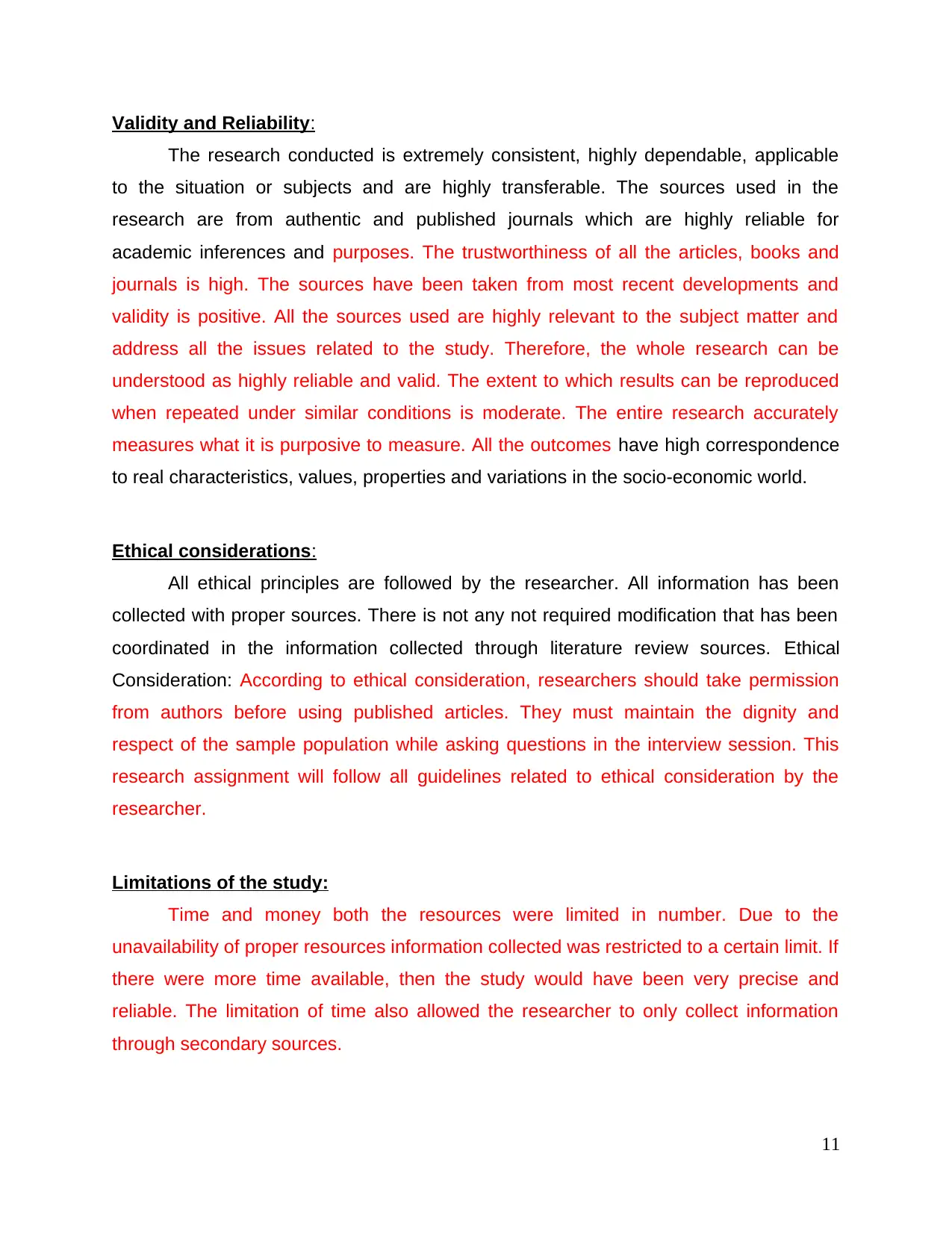
Validity and Reliability:
The research conducted is extremely consistent, highly dependable, applicable
to the situation or subjects and are highly transferable. The sources used in the
research are from authentic and published journals which are highly reliable for
academic inferences and purposes. The trustworthiness of all the articles, books and
journals is high. The sources have been taken from most recent developments and
validity is positive. All the sources used are highly relevant to the subject matter and
address all the issues related to the study. Therefore, the whole research can be
understood as highly reliable and valid. The extent to which results can be reproduced
when repeated under similar conditions is moderate. The entire research accurately
measures what it is purposive to measure. All the outcomes have high correspondence
to real characteristics, values, properties and variations in the socio-economic world.
Ethical considerations:
All ethical principles are followed by the researcher. All information has been
collected with proper sources. There is not any not required modification that has been
coordinated in the information collected through literature review sources. Ethical
Consideration: According to ethical consideration, researchers should take permission
from authors before using published articles. They must maintain the dignity and
respect of the sample population while asking questions in the interview session. This
research assignment will follow all guidelines related to ethical consideration by the
researcher.
Limitations of the study:
Time and money both the resources were limited in number. Due to the
unavailability of proper resources information collected was restricted to a certain limit. If
there were more time available, then the study would have been very precise and
reliable. The limitation of time also allowed the researcher to only collect information
through secondary sources.
11
The research conducted is extremely consistent, highly dependable, applicable
to the situation or subjects and are highly transferable. The sources used in the
research are from authentic and published journals which are highly reliable for
academic inferences and purposes. The trustworthiness of all the articles, books and
journals is high. The sources have been taken from most recent developments and
validity is positive. All the sources used are highly relevant to the subject matter and
address all the issues related to the study. Therefore, the whole research can be
understood as highly reliable and valid. The extent to which results can be reproduced
when repeated under similar conditions is moderate. The entire research accurately
measures what it is purposive to measure. All the outcomes have high correspondence
to real characteristics, values, properties and variations in the socio-economic world.
Ethical considerations:
All ethical principles are followed by the researcher. All information has been
collected with proper sources. There is not any not required modification that has been
coordinated in the information collected through literature review sources. Ethical
Consideration: According to ethical consideration, researchers should take permission
from authors before using published articles. They must maintain the dignity and
respect of the sample population while asking questions in the interview session. This
research assignment will follow all guidelines related to ethical consideration by the
researcher.
Limitations of the study:
Time and money both the resources were limited in number. Due to the
unavailability of proper resources information collected was restricted to a certain limit. If
there were more time available, then the study would have been very precise and
reliable. The limitation of time also allowed the researcher to only collect information
through secondary sources.
11
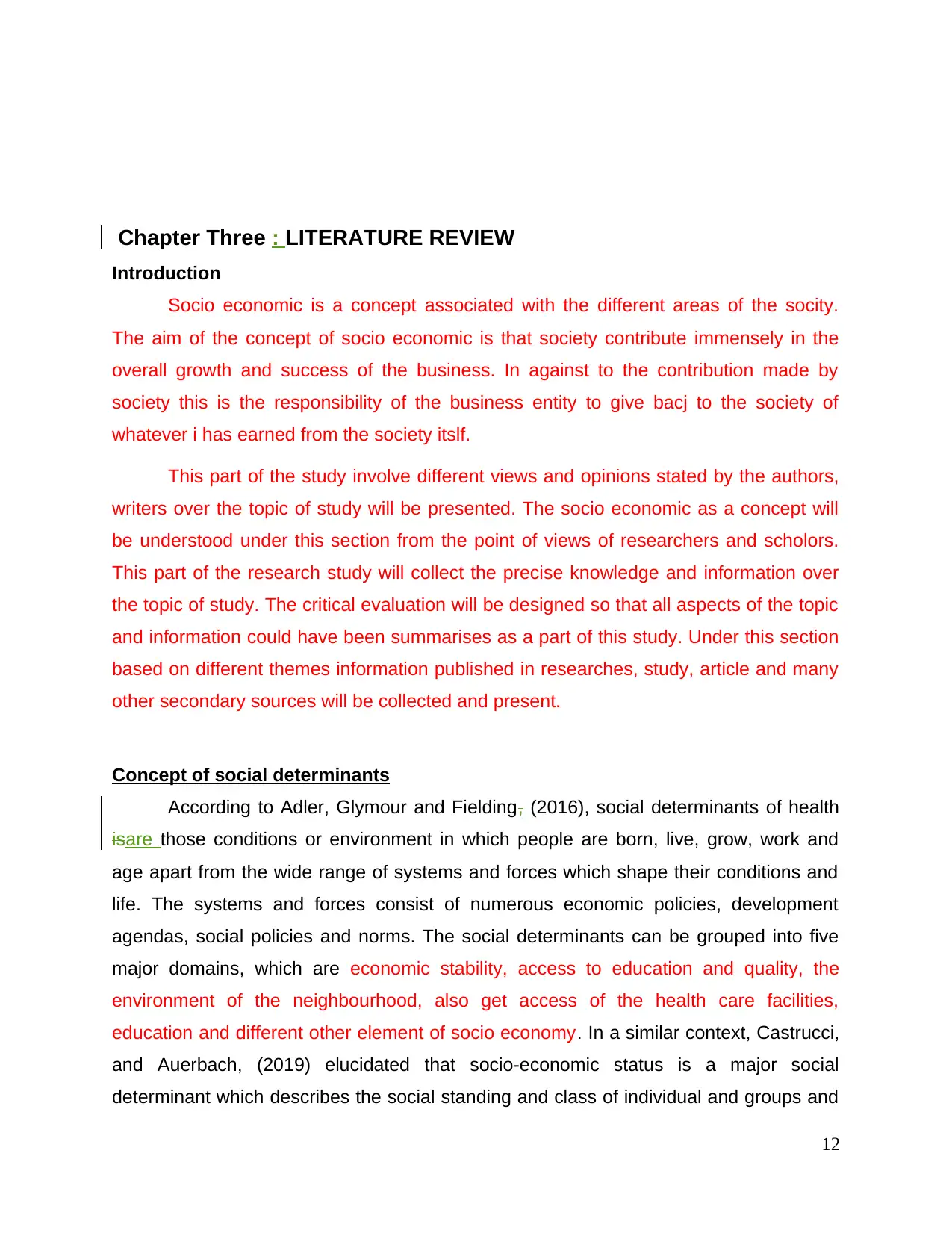
Chapter Three : LITERATURE REVIEW
Introduction
Socio economic is a concept associated with the different areas of the socity.
The aim of the concept of socio economic is that society contribute immensely in the
overall growth and success of the business. In against to the contribution made by
society this is the responsibility of the business entity to give bacj to the society of
whatever i has earned from the society itslf.
This part of the study involve different views and opinions stated by the authors,
writers over the topic of study will be presented. The socio economic as a concept will
be understood under this section from the point of views of researchers and scholors.
This part of the research study will collect the precise knowledge and information over
the topic of study. The critical evaluation will be designed so that all aspects of the topic
and information could have been summarises as a part of this study. Under this section
based on different themes information published in researches, study, article and many
other secondary sources will be collected and present.
Concept of social determinants
According to Adler, Glymour and Fielding, (2016), social determinants of health
isare those conditions or environment in which people are born, live, grow, work and
age apart from the wide range of systems and forces which shape their conditions and
life. The systems and forces consist of numerous economic policies, development
agendas, social policies and norms. The social determinants can be grouped into five
major domains, which are economic stability, access to education and quality, the
environment of the neighbourhood, also get access of the health care facilities,
education and different other element of socio economy. In a similar context, Castrucci,
and Auerbach, (2019) elucidated that socio-economic status is a major social
determinant which describes the social standing and class of individual and groups and
12
Introduction
Socio economic is a concept associated with the different areas of the socity.
The aim of the concept of socio economic is that society contribute immensely in the
overall growth and success of the business. In against to the contribution made by
society this is the responsibility of the business entity to give bacj to the society of
whatever i has earned from the society itslf.
This part of the study involve different views and opinions stated by the authors,
writers over the topic of study will be presented. The socio economic as a concept will
be understood under this section from the point of views of researchers and scholors.
This part of the research study will collect the precise knowledge and information over
the topic of study. The critical evaluation will be designed so that all aspects of the topic
and information could have been summarises as a part of this study. Under this section
based on different themes information published in researches, study, article and many
other secondary sources will be collected and present.
Concept of social determinants
According to Adler, Glymour and Fielding, (2016), social determinants of health
isare those conditions or environment in which people are born, live, grow, work and
age apart from the wide range of systems and forces which shape their conditions and
life. The systems and forces consist of numerous economic policies, development
agendas, social policies and norms. The social determinants can be grouped into five
major domains, which are economic stability, access to education and quality, the
environment of the neighbourhood, also get access of the health care facilities,
education and different other element of socio economy. In a similar context, Castrucci,
and Auerbach, (2019) elucidated that socio-economic status is a major social
determinant which describes the social standing and class of individual and groups and
12
⊘ This is a preview!⊘
Do you want full access?
Subscribe today to unlock all pages.

Trusted by 1+ million students worldwide
1 out of 37
Related Documents
Your All-in-One AI-Powered Toolkit for Academic Success.
+13062052269
info@desklib.com
Available 24*7 on WhatsApp / Email
![[object Object]](/_next/static/media/star-bottom.7253800d.svg)
Unlock your academic potential
Copyright © 2020–2025 A2Z Services. All Rights Reserved. Developed and managed by ZUCOL.





